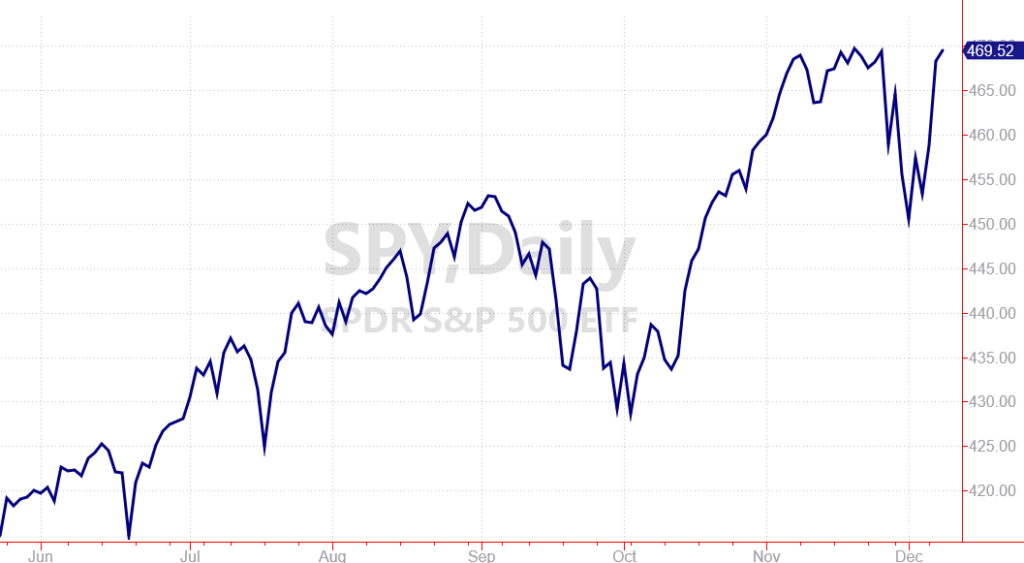
The stock market selloff is over after just a few days of weakness.
For all the hysteria and concern about the Omicron variant, the U.S. stock market has been extremely resilient. Check out the quick market selloff (and recovery) for the S&P 500 below:

Of course pockets of weakness still remain. And there are certainly concerns with certain areas of the market — especially growth stocks with high valuations and questionable earnings.
But the quick stock market recovery is a good reminder of why we never want to make emotional decisions with our investments. And it’s typically best to make investment shifts gradually as new themes develop. That way, you’re not jumping in and out of investments too quickly.
Emotional investors tend to buy high (as euphoria and hubris sets in), and sell low (thanks to fear and uncertainty). That’s a recipe for disaster.
Congrats to the investors who made wise choices during this recent pullback. For now, let’s take a look at some of the most important links for staying on top of this dynamic market.
What Stock Market Selloff?
- Bloomberg: Apple nears $3 trillion in market value.
- Since the end of the 1990’s Apple has returned 22,000%.
- Shares trade at 30 times 12-month earnings expectations.
- The stock could benefit from new products and investor flight to safety.
- FT: Retail traders bought the dip after Omicron pullback.
- Investors poured $10 billion into US equity funds.
- Retail investors were especially active according to VandaTrack.
- Amateur traders generally focusing on stocks that have fallen.
- Bloomberg: Energy ETFs receive capital inflows.
- Investors added $500 million to energy ETFs last week.
- This was the largest weekly addition since May 2020.
Corporate Risks to Consider
- Mehlman: Top risks for 2022.
- The number one risk for 2022 is extreme expectations.
- Accelerating pace of cyber attacks poses a larger risk.
- The rise of inflation creates political conflicts.
- WSJ: Amazon fined $1.3 billion in Italian antitrust case.
- Amazon harmed competitors by favoring certain third-party sellers.
- Sellers that used Amazon’s warehouse services received preference.
Shortages and Inflation
- Bloomberg: Ship logjam is longer than ever.
- 96 ships currently sit off the coast of California.
- The average wait times for ships is 20.8 days.
- Importers typically book January orders in advance – no relief in sight.
- Bloomberg: Chip delivery wait times grow again.
- Lead time between chip order and delivery increased to 22.3 weeks.
- Companies like AAPL and Ford can’t meet demand for own products.
- Power management chips and microcontrollers in are particularly scarce.
- WSJ: U.S. jobless claims fall to 184,000.
- Claims hit their lowest levels in more than 50 years.
- Employers are reluctant to lay off workers with such a tight job market.
- There were 11 million job openings in October — up from 10.6 mil in Sept.
- WSJ: The cost of rent is rising fast. Here’s what Americans can do.
- The median cost of rent has risen by nearly 20% in select cities.
- Consumers also pressured by energy, food and transportation costs.
Crypto Selloff Makes Stock Market Look Tame
- CoinDesk: Crypto selloff pauses, sentiment turns bearish.
- Bitcoin found support near the 200-day average.
- Excess leverage (borrowing) in crypto market helped fuel selloff.
- Negative sentiment (currently) leaves room for more upside.
- CoinDesk: Bitcoin trading volume continued to decline.
- Bitcoin prices have hovered near $50,000 over last few days.
- The CEOs of six major crypto companies spoke to U.S. Congress.
- CoinDesk: House meets on crypto regulation.
- The hearing lasted 4 hours and 49 minutes.
- “Regulation by enforcement” is unfair to companies without clarity.
- Crypto industry “consumes enough energy to power a small nation.”
- Bloomberg: Crypto crash weighs on DeFi tokens.
- Many DeFi tokens failed to rebound this week even alongside BTC.
- Many DeFi tokens have very low liquidity, so pressure hits harder.
- Investors and traders also worried about regulatory crackdowns.